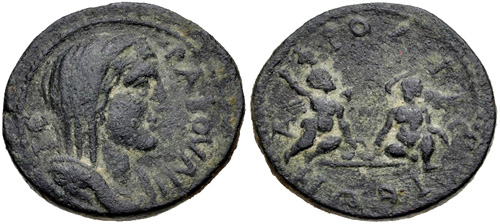 Asclepiades (third century B.C.) writes, “I am not yet two and twenty, and life is a burden to me. Ye Loves, why thus maltreat me; why set me afire? For if I perish, what will you do? Clearly, Loves, you will play, silly children, at your knuckle-bones as before” [12.46]. Meleager describes how, “Still in his mother’s lap, the child Eros, playing with knuckle-bones in the morning, gambled my life away” [12.47, transl. Peter Jay]. For Anacreon, “The dice of Love are madness and uproar.” See also Apollonius Rhodius 3.114ff. and Antipater of Sidon 7.427. In his commentary on Meleager, Jerry Clack writes, “Dice are an appropriate symbol for love” (p.63).
Asclepiades (third century B.C.) writes, “I am not yet two and twenty, and life is a burden to me. Ye Loves, why thus maltreat me; why set me afire? For if I perish, what will you do? Clearly, Loves, you will play, silly children, at your knuckle-bones as before” [12.46]. Meleager describes how, “Still in his mother’s lap, the child Eros, playing with knuckle-bones in the morning, gambled my life away” [12.47, transl. Peter Jay]. For Anacreon, “The dice of Love are madness and uproar.” See also Apollonius Rhodius 3.114ff. and Antipater of Sidon 7.427. In his commentary on Meleager, Jerry Clack writes, “Dice are an appropriate symbol for love” (p.63).Illustrated here is the famous Roman statue of the girl playing knucklebones from Berlin.

The
type of two seated Erotes playing astragaloi (knucklebones) was struck only in Aphrodisias in Caria, though it is analogous to similar issues (with
children who are not, however, winged) from Ephesus (left) and Samos in Ionia,
Hypaepa in Lydia, and Hierapolis in Phrygia.
* Aphrodisias in Caria, small coins, Gordianic, with obverse bust of Boulé draped r. and reverse as described. Despite the comparatively large number of specimens recorded by MacDonald in The Coinage of Aphrodisias, most of them in major public collections, this coin is in my experience very much rarer than (for example) the similar type from Ephesus with non-winged children.

Æ 20, 1 h, 4.91g. Obv. ΙΕΡΑ ΒΟΥΛΗ. Veiled and draped bust of Boulé r. Rev. ΑΦΡΟΔΙCΙΕΩΝ. Two Erotes playing knucklebones (Photo courtesy of Classical Numismatic Group, Inc., www.cngcoins.com)
Æ 18, 1 h, 2.71g. Similar.
CATALOGUE
Aphrodisias / Boulé
References: RPC VII, 1, 636; MacDonald, The Coinage of Aphrodisias, type 123
Rarity: Common (but see text above)
References: RPC VII, 1, 636; MacDonald, The Coinage of Aphrodisias, type 123
Rarity: Common (but see text above)

No comments:
Post a Comment
Note: Only a member of this blog may post a comment.